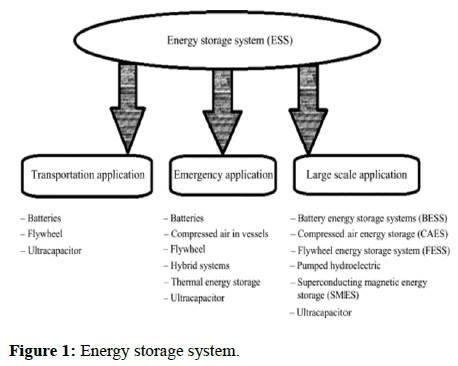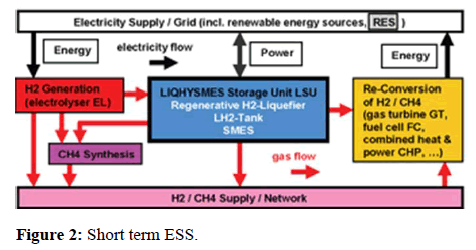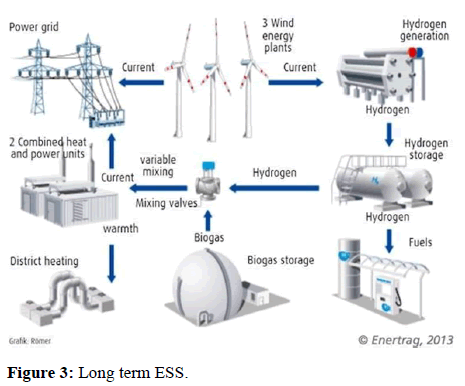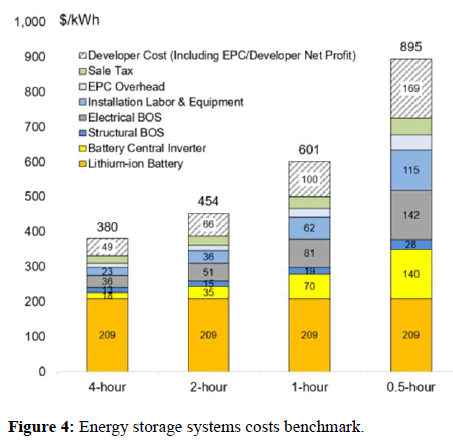Review Article, J Electr Eng Electron Technol Vol: 12 Issue: 5
A Review on Various Optimization Approaches for Storage Mechanism in Renewable Energy System
Gopinatha Panicker*
Department of Electrical Engineering, Satyabama Institute of Science and Technology, Chennai, Tamil Nadu, India
*Corresponding Author: Gopinatha Panicker
Department of Electrical Engineering, Satyabama Institute of Science and Technology, Chennai, Tamil Nadu, India
E-mail: gopinathpanicker@gmail.com
Received date: 03 April, 2023, Manuscript No. JEEET-23-94540;
Editor assigned date: 05 April, 2023, PreQC No. JEEET-23-94540 (PQ);
Reviewed date: 19 April, 2023, QC No. JEEET-23-94540;
Revised date: 02 June, 2023, Manuscript No. JEEET-23-94540 (R);
Published date: 09 June, 2023, DOI: 10.36648/2325-9833.1000964
Citation: Panicker G (2023) A Review on Various Optimization Approaches for Storage Mechanism in Renewable Energy System. J Electr Eng Electron Technol 12:5.
Abstract
The demand of energy has been achieved substantial attention all over the world nowadays. To meet the supply requirements, the newly emerging renewable energy technologies has been preferred as a strong alternative which could meet the demand. Most prominent renewable form of energy resources are solar system, wind energy and tidal power. Among them the solar energy assists with maximum amount of power. Also, hybrid form of renewable energy systems are also becoming wide applicable. They include the combination of one or more renewable energy resources. For attaining maximum power from the suggested renewable sources, maximum power point tracking solution is used. Several energy storage systems are existing for storing the energy/power attained from the renewable energy resources. Battery storage, super capacitors, flywheel are some of the storage system. Optimization approach assures advanced storage mechanisms in renewable energy system. This research work provides a comprehensive review on existing optimization approaches for storage in renewable energy resources along with its merits, demerits and future research direction.
Keywords: Battery storage; Flywheel; Optimization; Renewable resources; Super capacitor
Introduction
The energy resources are estimated to be very much crucial for economic and political point of view all over the world and hence changes in technological change in energy system is an inevitable factor which requires advancement. Several electricity sectors across the world are focusing on a huge growth in the renewable energy generation capability which is further predictable to be continued in the same scale. Major part of the renewable generation of energy is attained from the sun. With respect to the geographical extent of the generating entity, the sum of acquired energy from any renewable energy resource changes [1]. Converter, rectifier and the Maximum Power Point Tracking (MPPT) are commonly used to yield supreme amount of power from the renewable form of energy resources. Energy storage arrangement is the most critical part which increases the reliable nature of the renewable energy system [2].
For daily plan terms, a kind of resolution is implemented in Conte, et al. Here the effective mechanism of renewable resources are interpreted and an efficient way of energy storage system is carried out. A structure of the multi-objective based optimization of a hybrid means of renewable energy model is discussed in Fadaee, et al. In this, the storage mechanism is accomplished by the process of converting the energy to economical means of storage sequences [3]. Several ways of energy storage mechanisms are present and the efficiency mainly depends on the identification and implementation of the system. This kind of system is constructed on the basic elements such as cost, storage capability, lifetime, extent and the surrounding. System operators are established to be demanding while considering the speed factor of the present existing electrical loads. This is to control the resources they could exploit renewable and non-renewable form of energy resources for attaining the energy demand criteria [4].
Major scope of renewable energy resource is that it is freely available resource and any one could utilize solar energy for power generation [5]. Still, the storage capability of the attained energy remains as a research problem which requires further developments. Some of the existing form of storage systems available are battery storage system, super capacitor, etc. General form of energy storage organization is represented as follows in Figure 1.
In renewable energy based power systems, an essential challenge is to meet the supply and the demand curve [6]. Traditional form of renewable energy scheme along with the battery operated storage is practically costly. The power generated from the sun is intermittent in nature and the load demand varies quickly. Hence energy storage system is quite necessary for highly fluctuating power profile [7]. Proper choice of energy storage system includes several aspects such as system performance level, system capacity, kind of application and the storage system. The cost of the batteries is a significant factor which holds a major part in fixing charge of small individual systems. Also, when a battery capability reduces, then the battery should be replaced since its nominal reliability could not be assured [8].
Energy storage technologies
This section will discuss the energy storage technologies. The general classification of Energy Storage Systems (ESS) based on storage period will be discussed [9].
Short term ESS: This section will discuss the short term energy storage systems like battery, hydrogen storage and pumped hydroelectric storage. The Figure 2 describes the short term ESS flow diagram.
One such successive approach of storing the excess amount of energy from the renewable energy system during the off peak hours is the assembly and stowage of hydrogen since it possesses a power rate array in the command of 10 MW and they are appropriate for long term storage constraint [10]. Hydrogen is wide applicable in diverse fields whereas fossil fuel dominate on the same by eliminating the harmful emissions. Production of hydrogen by means of renewable means could be achieved through numerous methods and water electrolysis is the popular among them. Here the water gets split up into hydrogen and oxygen by means of application of direct current electricity. Some of the substantial water electrolysis includes alkaline which are the proton exchange film and the solid oxide electrolysis [11].
Pumped hydro storage system is the significant means of expertise that has been evolved in huge measure energy storage market place for an extensive time period. Following the pumped hydro storage, the compressed air energy storage system has the second big inclusive energy storage ability. A comprehensive methodology is presented which optimally controls lead acid batteries operating under dynamic pricing schemes in dual forms of independent and aggregated ways. In battery based energy storage systems, the optimization of operation and the controller strategies were determined by means of evolutionary approach [12]. A general structure has been exploited for planned disposition of a lithium ion based energy storage system to thrive the benefits in a distribution feeder system. A convex based optimization approach was mentioned to schedule the charging and discharging time proficiency of the lithium ion based battery energy storage system.
Long term ESS: This section will discuss the short term energy storage systems like flywheel and super capacitor. Figure 3 mentions the long term ESS system.
Flywheel based energy storage arrangement is one of the earlier forms of energy storage approaches. This assists as an effective manner of bulk energy storage and they are made of rotating cylinder, bearing system, motor machine and a generator. The flywheel working mechanism follows angular momentum. These flywheels consists of rotational discs and the kinetic form of energy is stored by means of spinning a disk or rotor nearby its concerned axis [13]. Quantity of energy stored in the disk is straight proportional to the square of the speed of the wheel and the rotor’s mass moment of inertia. At the instance power is obligatory, the flywheel usages rotor inertia and it transforms the stored kinetic energy to electricity.
Speed level of the flywheel increases at the time of charging process and relatively the speed decreases during the discharging mode of operation. These are divided mainly into low speed device and high speed device. The super capacitors are considered as the short term based energy storage strategies [14]. This is mainly suitable for power systems in times of transitory stages. These attains minimum amount of ecological effects when connected to new kind of systems. One such major gain of the super capacitors over the batteries is the quick charging and discharging ability. However the density of the super capacitors are found to be minimum than batteries and they does not provide big storage system based application. This is due to the huge cell requirement and obviously ends in complex structure. The Figure 4 mentions the cost standard of the energy storage systems [15].
Literature Review
This section will discuss the related work of the study. The existing works on optimization techniques for ESS will be discussed.
Optimization techniques
This section will discuss the different optimization methods/algorithms employed in existing works for optimizing storage systems in renewable energy systems.
The optimal way of energy resource could be accomplished by engaging optimization aligned control strategies, as energy management is measured as a crucial standard for appropriate gathering of hybrid means of power generation systems. Presently existing energy storage schemes could be combined in numerous utility based applications which deeds as a buffer between the compeers and load to support constant dispersal of the electricity that has been functioning in day to day life. It grants an effectual harmony search algorithm for the resolution of charge forecast of an energy storage system alongside with renewable power generators below the time of use pricing and the demand charge program [16-18]. A novel form of energy management system is established to effectively collaborate a hybrid form of energy storage system positioned on the pumped hydro storage system along with batteries. Suitable arrangement and forecast way of energy storage system for the congestion managing is offered in Hemmati, et al. At this time the supreme imperative aspects measured were the capacity and rated power. To improve the energy efficiency and battery lifespan time for the battery semi active hybrid management, an optimization centered control methodology is offered in Yin, et al. Model Predictive Control based method is proficient in Hu, et al., to exploit the battery lifespan and the storage capacity. None dominated sorting genetic algorithm II has been organized for planning an optimal observation of electrical energy storage scheme for prevalent island distributed network. A mathematical epitome of the arrangement of the battery storage systems were projected with several types of batteries in which the effects of battery brands and the capacity deficiency topographies on the optimal capacity features of the battery energy storage systems and the power forecast patterns of the hybrid power systems were studied.
For the finest location of the battery energy storage system in the delivery system to diminish the distribution system losses, a loss sensitivity centered system has been estimated. Correspondingly contributes an effective technique for stipulating the optimal extent of the battery energy storage system with the support of particle swarm optimization procedure. By embracing a multi objective optimization process positioned on an amplified way a decision sustenance tool for energy storage choice standards is recommended in Li, et al., battery energy storage systems were defined to contribute in the FFR market of the UK national grid in Lian, et al.
To enhance the energy stowage dispatch program for demand charge management in a grid connected and united photovoltaic battery storage system, a linear programming routine has been applied. Here the optimization system is outlined as a linear program and it controls day ahead PV power output and the load estimations with reliable updates to describe the appropriate time to charge or discharge the battery focus to fundamental dynamical and electrical performance bounds of PV+ system [19]. The energy management approach is generally combined with optimization to certify the stability of load supply demand and to decline the cost of energy production rate. For reducing overall energy storage system size and extend the battery life cycle, the ultracapacitor hybrid energy storage has been suggested as a solution where ultracapacitor acts as a power buffer to charge or discharge the peak power. Two scenarios of community energy storage ownership were proposed in Terlouw, et al., which demonstrates a cost-effective system policy for all lithium ion batteries and vanadium redox flow battery for both energy arbitrage and energy arbitrage-peak shaving scenarios. An affine arithmetic based multi-objective optimization method was suggested for the optimal action of energy storage systems in dynamic distribution networks with certain uncertainties [20].
Discussion
For the purpose of handling indecisions of DGs and the loads, affine arithmetic was made practical to the optimization based ideal. By having the solar renewable device, the new form of optimum energy control system was reviewed in smart grid based environs. An adaptive dynamic programming is mainly gathered to perceive iterative form of control law series of the battery. It is a self-learning based set of rules. The initial contribution which denotes the development of a novel advanced methodology is examined which describes the purpose of modelling and optimally sizing a hybrid form of system for renewable energy mainly allows for two storage devices. An advanced battery energy storage system was anticipated based on optimal provision method for multiple agents in a delivery system design. At first, the electricity market mechanism is projected to a distribution based system. The relative energy contract procedure is exhibited for different agents such as wind farms, solar power stations, and demand aggregators.
Comparative analysis
This section will present the comparative study of various optimization approaches used in optimization of energy storage methods in existing works in terms of objectives, optimization techniques utilized, merits, demerits and future directions/research gaps in a tabular format (Table 1).
| S. no. | Optimization techniques used | Merits | Demerits | Future direction | Research gap |
|---|---|---|---|---|---|
| (1) | Hybrid energy storage system. | When starts functioning, continuous power obtained. | High cost installation. | Novel optimization systems which are proficient to resolve complex optimization related complications. | Optimization based control policies and predictive control strategies with advanced intricacy essential to be established for hybrid systems to additionally increase the perception of renewable energy. |
| (2) | Optimization method approach for planning and real-time control of integrated PV systems. | Maximizes the economic gain with respect to the request of precise profile shape. | PV fluctuations occurred. | Progressive PV forecasts prototypes to expand the efficiency of the existing approach will be directed. | Day-ahead scheduling and the real-time control of an integrated scheme. |
| (3) | Optimal placement of dispersed energy storage systems by using artificial bee colony algorithm. | Proposed ESS placement approach could successfully attain the objectives of voltage profile improvement. | Suitable only for large-scale distribution system. | Intelligent control systems that deliberate the online communication between the placed ESSs will be applied. | Since the optimal ESS placement generally depends on performance enhancement marks, a tradeoff should be prepared. |
| (4) | Robust Mixed-Integer Linear Program (RMILP). | Its flexibility in terms of solution accuracy and computational burden, together being measured by the number of uncertainty plans used. | High cost. | To integrate the cycle-counting algorithm dynamically rather than treating it as endogenous. | Battery capacity decline is designed only for the most promising solutions. |
| (5) | Hybrid renewable energy system- optimal energy management system. | The multi-objective utility to be optimized accorded the operating costs objective function. | Five energy devices (wind/photovoltaic/battery/fuel cell/electrolyzer) were used. | To verbalize and estimate a multi-objective optimization problem. | |
| (6) | Harmony search optimization of renewable energy charging. | Harmony search decrease together the peak power and acquisition of electricity all through on-peak time. | Suggested system should be joined with some forecast algorithms since generation and load possibly will not track the similar array every day as expected in this study. | The study considering the added elements connected to ESSs such as the efficiency, lifetime, and the system storage cost itself will be a significant comprehensive research. | Exhaustive remarks and explores for more assorted conditions should be achieved. |
| (7) | Optimal hybrid pumped hydro-battery storage pattern for off-grid renewable energy systems. | Hybrid storage system seems to be better sized for consideration in optimized solar/wind conditions. | Hybrid storage system also decreases the restriction of renewable generation. | A number of expansions could be measured such as the progress of an energy management strategy based on the use of load and generation forecasts. | To plan consistent and cost effective renewable energy systems, specifically when supplying off-grid loads. |
| (8) | Congestion managing in electric power systems. | The planning can challenge the uncertainties and manage congestion of the network. | Ambiguity of wind and solar units. | ESSs definitely expands voltage profile and stability margin of the network by reducing total loss and total flow in the network. | Storage units should be optimally charged and discharged to tackle the improbability. |
| (9) | Optimization based control strategy. | Extend battery life time. | The current disparity in the battery pack is moderately enormous at the commencement. | To enhance performance while compared to ACS. | To express the optimization problem, inclinations of the battery and the super-capacitor packs should be signified. |
| (10) | Optimization of battery energy storage system with the support of super-capacitor. | Enables the battery to meet the energy demand. | Suppresses variation on the battery current. | Advanced algorithm to improve the performance. | Charging/discharging cycles should be minimized. |
| (11) | Unified model to enhance outline of battery energy storage. | BESS with many kinds of batteries has certain economic advantages. | High cost. | An active tool to regulate the optimal capability alignments. | It is critical to embrace precise battery capacity degradation prototypes to better define the vibrant features of battery fade. |
| (12) | Multi-objective optimization approach. | A decision-making context for energy storage range is advanced. | Several limitations are there for current model. | Additional restraints could be added to familiarize the model to diverse application states with focused necessities. | Model with reduced losses is focused. |
| (13) | Optimization with a simulated annealing system of a hybrid system. | Six hybrid arrangements for renewable energy that stream a remote electrical load are exhibited. | Interruption of the life cycle cost is specified. | Revised types of the simulated annealing algorithm-based chaotic search and harmony search should be established. | To assimilate a high level of flexible wind and solar energy, energy storage is essential. |
Table 1: Comparative analysis of existing research works.
Conclusion
An assessment of several optimization approaches to enhance the wide range of energy storage problems related to renewable energy resource was presented. To advance the constancy and consistency of the hybrid power systems, it is one of feasible means to institute an energy storage method by means of diverse forms of parameters. The mentioned existing strategies were discussed based on its merits and demerits. Such a review contains possible information about different areas to be optimized and the existing techniques discussed in literature to optimize the specific parameters.
References
- Bussar C, Moos M, Alvarez R, Wolf P, Thien T, et al. (2014) Optimal allocation and capacity of energy storage systems in a future European power system with 100% renewable energy generation. Energy Procedia 46:40-47.
- Chong LW, Wong YW, Rajkumar RK, Rajkumar RK, Isa D (2016) Hybrid energy storage systems and control strategies for stand alone renewable energy power systems. Renewable Sustainable Energy Rev 66:174-189.
- Conte F, Massucco S, Saviozzi M, Silvestro F (2017) A stochastic optimization method for planning and real time control of integrated pv-storage systems: Design and experimental validation. IEEE Trans Sustain Energy 9:1188-1197.
- Das CK, Bass O, Kothapalli G, Mahmoud TS, Habibi D (2018) Optimal placement of distributed energy storage systems in distribution networks using artificial bee colony algorithm. Appl Energy 232:212-228.
- Dragicevic T, Pandzic H, Skrlec D, Kuzle I, Guerrero JM, et al. (2014) Capacity optimization of renewable energy sources and battery storage in an autonomous telecommunication facility. IEEE Trans Sustain Energy 5:1367-1378.
- Fadaee M, Radzi MA (2012) Multi-objective optimization of a stand alone hybrid renewable energy system by using evolutionary algorithms: A review. Renewable Sustainable Energy Rev 16:3364-3369.
- Garcia-Trivino P, Fernandez-Ramirez LM, Gil-Mena AJ, Llorens-Iborra F, Garcia-Vazquez CA, et al. (2016) Optimized operation combining costs, efficiency and lifetime of a hybrid renewable energy system with energy storage by battery and hydrogen in grid connected applications. Int J Hydrog Energy 41:23132-23144.
- Geem ZW, Yoon Y (2017) Harmony search optimization of renewable energy charging with energy storage system. Int J Electr Power Energy Syst 86:120-126.
- Guezgouz M, Jurasz J, Bekkouche B, Ma T, Javed MS, Kies A (2019) Optimal hybrid pumped hydro-battery storage scheme for off-grid renewable energy systems. Energy Convers Manag 199:112046.
- Hemmati R, Saboori H, Jirdehi MA (2017) Stochastic planning and scheduling of energy storage systems for congestion management in electric power systems including renewable energy resources. Energy 133:380-387.
- Ippolito MG, Di Silvestre ML, Sanseverino ER, Zizzo G, Graditi G (2014) Multi objective optimized management of electrical energy storage systems in an islanded network with renewable energy sources under different design scenarios. Energy 64:648-662.
- Jiang Y, Kang L, Liu Y (2019) A unified model to optimize configuration of battery energy storage systems with multiple types of batteries. Energy 176:552-560.
- Kavadias KA, Apostolou D, Kaldellis JK (2018) Modelling and optimisation of a hydrogen based energy storage system in an autonomous electrical network. Applied Energy 227:574-586.
- Li L, Liu P, Li Z, Wang X (2018) A multi objective optimization approach for selection of energy storage systems. Comput Chem Eng 115:213-225.
- Lian B, Sims A, Yu D, Wang C, Dunn RW (2016) Optimizing LiFePO4 battery energy storage systems for frequency response in the UK system. IEEE Trans Sustain Energy 8:385-394.
- Lujano-Rojas JM, Dufo-Lopez R, Bernal-Agustin JL, Catalao JP (2016) Optimizing daily operation of battery energy storage systems under real-time pricing schemes. IEEE Trans Smart Grid 8:316-330.
- Nagarajan A, Ayyanar R (2014) Design and strategy for the deployment of energy storage systems in a distribution feeder with penetration of renewable resources. IEEE Trans Sustain Energy 6:1085-1092.
- Barath JG, Husev O, Manonmani N (2015) Overview of energy storage technologies for renewable energy. Int J Innov Sci Eng Technol 2:749-754.
- Nojavan S, Majidi M, Zare K (2017) Performance improvement of a battery/PV/fuel cell/grid hybrid energy system considering load uncertainty modeling using IGDT. Energy Convers Manag 147:29-39.
- Olatomiwa L, Mekhilef S, Ismail MS, Moghavvemi M (2016) Energy management strategies in hybrid renewable energy systems: A review. Renewable Sustainable Energy Rev 62:821-835.
 Spanish
Spanish  Chinese
Chinese  Russian
Russian  German
German  French
French  Japanese
Japanese  Portuguese
Portuguese  Hindi
Hindi 




